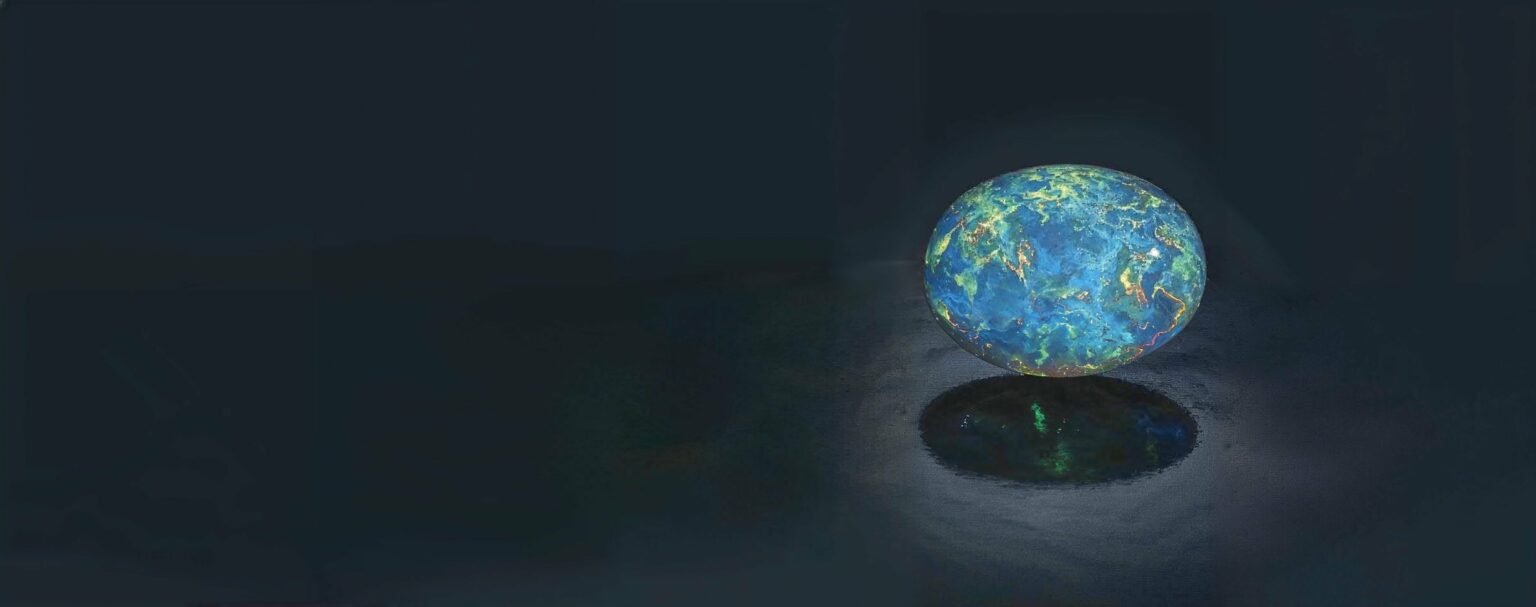Ask the average jeweler which variety of opal is the most prized in the world and chances are pretty good you’ll get the right answer: Australian black opal. But don’t ask which kind is the next best. The answers you’ll usually hear—Australian semi-black or boulder opal—are wrong.
Jewelers can be excused for not knowing the runner up in value terms to black opal. Unless they’re connoisseurs, they may never have heard of the world’s second most valued opal. Called black crystal opal, it’s also from Australia. But unlike, say, boulder opal, which is a distinct variety of this gem, black crystal opal is more akin to a sub-species. Indeed, most opal guidebooks classify black crystal opal between well-known black and semi-black when it comes to both value and regard. So how come few jewelers know about it when it’s so highly esteemed?
That’s a tricky question, one whose answer sounds like a Zen riddle. Jewelers do know about crystal opal, only they don’t know that they know.
Unless explained by an expert, black crystal opal is very likely to be mistaken for black, semi-black or even gray opal. That’s because most jewelers who have seen black crystal opal probably weren’t told what they were looking at.
The same goes for light crystal opal—even more so. Since crystal opal occurs in both light and dark forms, and since light (or white) opal is a jewelry store staple, the odds are great that jewelers may have sold, not only seen, light crystal opal.
Now they must learn to identify it, especially since black crystal beauties from Lightning Ridge, Australia’s most famous opal mining area, are coming on the world market in the greatest profusion in decades. As consumers take note of this stunning opal, jewelers will need to familiarize themselves with it for selling and appraisal purposes. This profile is meant to get your education started.
Great Balls of Fire
The name opal is a shortened version of opalus, a Roman coinage that sums up this gem’s chief aesthetic attribute: color play. Perhaps the best description of opal ever penned is found in Pliny the Elder’s (d. 79 A.D.) treatise, “Natural History,” which devotes a volume to gems: “For in them you shall see the living fire of ruby, the glorious purple of amethyst, the sea-green of the emerald, all glittering together in an incredible mixture of light.”
Although the world marveled at opal for centuries, the precise cause of its color play, also known as iridescence, was not known until the 1960s. Then electron microscope studies revealed that the richness and brilliance of opal colors were the result of light diffraction (the breakup of light rays into spectral colors) within the stone. Here’s how opal works its color magic:
Light enters a stone, passes through lattices of silica spheres into a surrounding silica solution where it is diffracted and reflected out of the stone.
Gemologists found that both the size of these spheres and the orderliness with which they are arranged influence the number, strength and pattern of colors on opal exhibits. “For instance,” writes Andrew Cody in his photo guide, “Australian Precious Opal,” “blue colors are evident where the spheres are smaller, and at the other end of the spectrum orange and red will be evident where the spheres are larger.”
In short, sphere size correlates with specific wavelengths of light transmitted from stones. Depending on the range of sphere sizes, many or just a few colors are emitted. Moreover, spheres have to be grouped together with sufficient regularity to ensure broad, vivid colors.
A Matter of Contrast
Color vividness in opal is a function of body color, a term that refers to the tonal background in which opal’s spectral colors swim. Basically, there are two classifications of body color: light and dark. The former includes those backgrounds from milky white to medium gray and the latter backgrounds from strong gray to jet black. Black opal’s appeal, over and above its greater rarity relative to white opal, is that its dark background acts as a color intensifier.
Whether light or dark, most opals have a colorless base, known as “potch,” that renders them opaque or slightly translucent. No matter how crisp and brilliant the color play of such opals, it will seem confined to the surface of the stone. However, when stones are highly translucent or transparent, their color is as visible inside the stone as on its surface.
Jelly Versus Crystal Opal
There are two kinds of transparent opal. The first, and more common, is called jelly opal and features colors that are hazy, intermittent and rarely effulgent. While sometimes magnificent, jelly opals have colors that seem to be suspended like flies in amber within the stone rather than to emanate from it. What’s more, jelly opals occur only in light opal form.
The second, far rarer, type of transparent opal is called crystal opal and occurs in both light and dark opal form. Indeed, anywhere in Australia where opal is mined, a certain percentage of it, 10% to 25% (depending on the opal field), is crystal. According to Dallas opal specialist George Williams, “Crystal opals do not have as great a variety of patterns as the opaque varieties. But they more than make up for this lack of variety with a depth of color that draws you deep within a stone. Often you feel like the color goes on for miles.”
At their best, crystal opals boast crisp, dramatic, or swirling colors that allow them to command up to $4,000 per carat at wholesale for top black crystal material and up to $1,000 per carat at wholesale for top light crystal goods. Without a doubt, black crystal opals from Lightning Ridge are the most sought after of this breed by collectors. Until now, black opal collecting was synonymous with Japan, which since around 1964 had been siphoning off practically the entire supply of better-grade Lightning Ridge stones.
Then two things happened to loosen Japan’s lock on the black opal market. Recession in that country dampened demand for goods by about 30% while resumption of full-scale mining at Lightning Ridge in 1991 pushed production to its highest levels in decades. Indeed, activity there can be characterized as an opal rush.
As a result, black crystal opal prices have slipped 5% to 10% for upper-echelon pieces, 15% to 25% for better-to-fine stones and 30% to 50% for commercial-to-medium grades—all in less than a year. That’s good news for U.S. jewelers, who will soon be barraged with the best buying opportunities for black opal since the early 1960’s. “Fine black crystal opal hasn’t been this available and affordable in years,” Williams says, “and may not be again for years to come.”
Please note: this profile was originally published in 1992 in Modern Jeweler’s ‘Gem Profiles/2: The Second 60’, written by David Federman with photographs by Tino Hammid.
The crystal black opal shown in the header image weighs 20.38 carats and is courtesy of George S. Williams Precious Gems Inc., Dallas.






